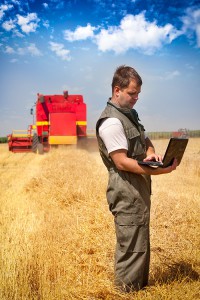 I occasionally research how technology is being applied to different fields. Lately, I have been thinking about how technology is helping agriculture. Obviously others have been thinking the same thing but with more of a profit motive in mind. In May of this year, there was a conference held in Palo Alto, California, titled “Silicon Valley Agtech.” Their tagline is “Silicon Valley AgTech is where technology meets agriculture, Silicon Valley meets the Silicon Prairie, and innovation comes back to the farm.” Their aim is to bring together agriculture technology startups and venture capitalists to try to accelerate the interest and growth of this industry in Silicon Valley. Here are a few technologies that are aiding farmers and ranchers now.
I occasionally research how technology is being applied to different fields. Lately, I have been thinking about how technology is helping agriculture. Obviously others have been thinking the same thing but with more of a profit motive in mind. In May of this year, there was a conference held in Palo Alto, California, titled “Silicon Valley Agtech.” Their tagline is “Silicon Valley AgTech is where technology meets agriculture, Silicon Valley meets the Silicon Prairie, and innovation comes back to the farm.” Their aim is to bring together agriculture technology startups and venture capitalists to try to accelerate the interest and growth of this industry in Silicon Valley. Here are a few technologies that are aiding farmers and ranchers now.
Telematics
Telematics is the combination of telecommunications and informatics. It has to do with sending information to and from a remote object such as a vehicle. The GPS unit in newer cars is one such example of telematics, but the agriculture industry is using it in unique ways. GPS technology in newer tractors and farm implements can tell the driver precisely where to plow, plant, spray, and harvest. Harvest yield information can be uploaded in real time so that a farmer can tell immediately what to expect from his crop. Of course, all of this information exchange is going to result in a larger amount of data to be processed.
Big Data
Information collected in the field will include a new array of data points and could easily move into the area of big data. Some farm service companies are already getting into the cloud services business, specifically to collect, process, and make sense of data points. You can either upload data from the tractor thumb drive or upload the telematics-collected data directly to the service provider. Either way, the service provider stores, analyzes, and creates visualizations to help you understand where you can improve your farming and your crop yield.
Robotics
Farm equipment is not quite to the point where it can drive itself (think Google tractor) but it is getting close. Sprinkler pivots in large farm fields are often computer controlled with a remote or an app and require little human intervention when set up properly. There are farm service companies, however, that are developing tractors and other equipment to operate without a driver. With the telematics mentioned above and smart cameras, they will be able to operate within the parameters and confines of a field. This will free up the farmer to do higher value work such as analyzing the yield report sent by his cloud service provider.
Thoughts
Technology can be used to aid efficiencies in fields (no pun intended) as diverse as agricultural production. This also represents new opportunities for entrepreneurs and IT workers who have a passion for farm production and want to work to increase yields and decrease waste.
Do you know of other fields that are increasing their use of technology in a unique way? Let me know. I am always interested in learning more.
Kelly Brown is an IT professional, adjunct faculty for the University of Oregon, and academic director of the UO Applied Information Management Master’s Degree Program. He writes about IT and business topics that keep him up at nigh



I never knew that a service provider analyzes and creates visualizations to help you understand where you can improve your farming. My uncle is thinking of buying a farm because he recently retired, and I am helping him do some research. We will have to contact a service in our area to help us with the data analysis aspect of things.